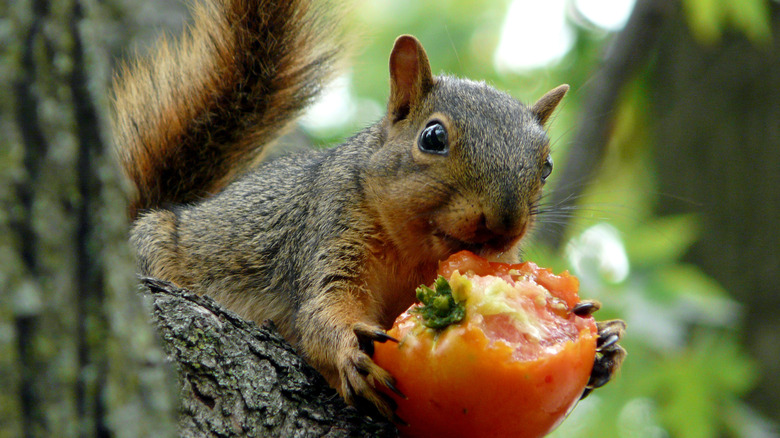Clear-Cut Signs That Squirrels Are To Blame For Your Tomato Problems
We may receive a commission on purchases made from links.
The relationship between homeowners and squirrels is not always a happy one. Adjectives like "cute" and "fluffy" go out the window when the rodents become the prime suspects in a string of garden burglaries. Before you take the necessary steps to get rid of the squirrels that are causing damage to your tomatoes, aka Solanum lycopersicum, you should be sure that they are the real perpetrators and not just scapegoats for some other tomato-loving pests. The clues are in the size of the holes, the number of missing tomatoes, nearby rodent sightings, and the presence of droppings.
There is a laundry list of tomato fruit problems to look out for, from black mold and end rot, to fruitworms and stink bug damage. There are also a number of non-insect pests that find the berries appetizing, including birds, raccoons, deer, and turtles. Not all deterrents work on every pest, so narrowing down the list will save you time and money.
What to look for (and what to do about it)
Because the insides of ripe tomatoes are soft and squishy, distinguishing between bites is slightly harder than it would be on leaves or gourds. But squirrels have a distinct calling card: their incisors. Squirrels carve holes into fruit instead of nibbling, pecking, or chomping like other animals. They also tend to take small bites out of several tomatoes instead of carrying the fruit away to consume it whole. If full tomatoes are missing or entire vines are bare, then your beef is with another species entirely. Actually seeing squirrels lurk around your garden is a major hint, but sometimes more scatalogical detective work is required. Squirrel droppings are dark, oblong pellets that are roughly twice the size of rat droppings (or ⅜- to a ½-inch in length) and often contain some undigested bits.
Once you're sure that squirrels are eating your tomatoes, it's time to take action. There are several ways to get rid of squirrels that include coating plants and the surrounding areas in vinegar, thiram, capsaicin, or coffee grounds. You may also choose to install protective netting to keep squirrels out ($13.49 on Amazon), spraying an all-purpose, non-toxic animal deterrent like Liquid Fence (around $20 for 32-ounces on Amazon), or building a raised planter box with a chicken wire enclosure to keep most large animals out. For more persistent tomato munchers, there are also catch and release traps or local pest control technicians that can help.

